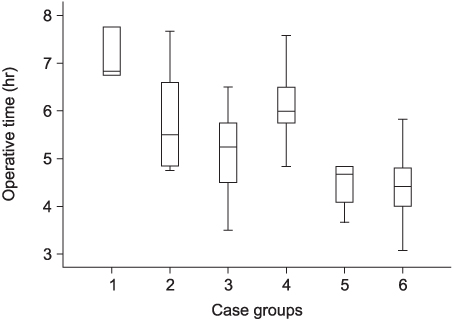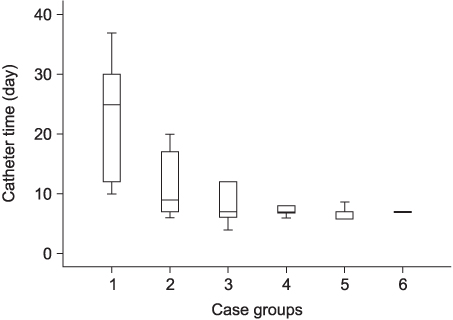Comparison of Perioperative Outcomes of Extraperitoneal Laparoscopic Radical Prostatectomy (ELRP) versus Open Radical Retropubic Prostatectomy (RRP): Single Surgeon's Initial Experience
- Affiliations
-
- 1Department of Urology, College of Medicine, Chungbuk National University, Cheongju, Korea.
- 2Department of Urology, Seoul National University Bundang Hospital, Seongnam, Korea. ssbyun@snubh.org
- KMID: 2139750
- DOI: http://doi.org/10.4111/kju.2007.48.2.131
Abstract
-
PURPOSE: Since its introduction into clinical practice, a laparoscopic radical prostatectomy (LRP) has been performed at a growing number of centers. LRP can be performed by either a transperitoneal or extraperitoneal approach. The perioperative morbidities were evaluated in two groups of patients; retropubic radical prostatectomy (RRP) or extraperitoneal laparoscopic radical prostatectomy (ELRP).
MATERIALS AND METHODS
Between December 2003 and March 2006, 45 patients were treated with a RRP, and between September 2005 and May 2006, 30 patients underwent an ELRP. The same surgeon performed both types of operation. The perioperative data, including operative time, transfusion rates, hospitalization length and duration of catheterization were analyzed. The pathological parameters, including Gleason score, pathological stage and positive surgical margin rates were also analyzed.
RESULTS
There were no significant differences in the preoperative characteristics between the two groups, with the exception of the mean age. The average operative time was significantly shorter in the RRP group (p<0.001). The other perioperative data showed no significant differences between the two groups (p>0.05). After gaining experience of 15 cases, the ELRP group showed significantly shorter catheterization time (p<0.005) and hospital stay (p=0.098). The pathological parameters of the two groups were comparable. RRP group were more likely to larger amount of postoperative analgesia (p=0.072). CONCLISIONS: The ELRP procedure showed comparable perioperative results to those of a RRP, with the exception of operative time. After our initial experience, the ELRP showed favorable outcomes with regard to catheterization time and hospital stay. Considering our results, ELRP can be recommended as one of the primary options for managing localized prostate cancer.
Keyword
MeSH Terms
Figure
Cited by 3 articles
-
Extraperitoneal Laparoscopic Radical Prostatectomy: Clinical Experience and Learning Curve with 103 Cases
Ho Suck Chung, Bu Hyeon Yun, Hyun Chong Ki, Seong Woong Na, Eu Chang Hwang, Chang Min Im, Seung Il Jung, Dong Deuk Kwon, Kwangsung Park, Soo Bang Ryu
Chonnam Med J. 2010;46(3):170-176. doi: 10.4068/cmj.2010.46.3.170.The Learning Curve Analysis of Laparoscopic Radical Prostatectomy: Comparison with Retropubic Radical Prostatectomy
Min Yong Kang, Ja Hyun Ku, Cheol Kwak, Hyeon Hoe Kim
Korean J Urol. 2008;49(1):18-23. doi: 10.4111/kju.2008.49.1.18.Comparison of Extraperitoneal and Transperitoneal Robot-Assisted Radical Prostatectomy in Prostate Cancer: A Single Surgeon’s Experience
Yong Seung Lee, Won Sik Ham, Won Tae Kim, Hui Jung Joo, Jin Sun Lee, Young Deuk Choi
Korean J Urol. 2009;50(3):251-255. doi: 10.4111/kju.2009.50.3.251.
Reference
-
1. Schuessler WW, Schulam PG, Clayman RV, Kavoussi LR. Laparoscopic radical prostatectomy: initial short-term experience. Urology. 1997. 50:854–857.2. Guillonneau B, Cathelineau X, Barret E, Rozet F, Vallancien G. Laparoscopic radical prostatectomy. Preliminary evaluation after 28 interventions. Presse Med. 1998. 27:1570–1574.3. Guillonneau B, Rozet F, Cathelineau X, Lay F, Barret E, Doublet JD, et al. Perioperative complications of laparoscopic radical prostatectomy: the Montsouris 3-year experience. J Urol. 2002. 167:51–56.4. Hoznek A, Samadi DB, Salomon L, De La Taille A, Olsson LE, Abbou CC. Laparoscopic radical prostatectomy: published series. Curr Urol Rep. 2002. 3:152–158.5. Rassweiler J, Sentker L, Seemann O, Hatzinger M, Rumpelt HJ. Laparoscopic radical prostatectomy with the Heilbronn technique: an analysis of the first 180 cases. J Urol. 2001. 166:2101–2108.6. Raboy A, Ferzli G, Albert P. Initial experience with extraperitoneal endoscopic radical retropubic prostatectomy. Urology. 1997. 50:849–853.7. Eden CG, King D, Kooiman GG, Adams TH, Sullivan ME, Vass JA. Transperitoneal or extraperitoneal laparoscopic radical prostatectomy: does the approach matter? J Urol. 2004. 172:2218–2223.8. Trabulsi EJ, Guillonneau B. Laparoscopic radical prostatectomy. J Urol. 2005. 173:1072–1079.9. Rozet F, Arroyo C, Cathelineau X, Barret E, Prapotnich D, Vallancien G. Extraperitoneal standard laparoscopic radical prostatectomy. J Endourol. 2004. 18:605–609.10. Ruiz L, Salomon L, Hoznek A, Vordos D, Yiou R, de la Taille A, et al. Comparison of early oncologic results of laparoscopic radical prostatectomy by extraperitoneal versus transperitoneal approach. Eur Urol. 2004. 46:50–54.11. Stolzenburg JU, Do M, Pfeiffer H, Konig F, Aedtner B, Dorschner W. The endoscopic extraperitoneal radical prostatectomy (EERPE): technique and initial experience. World J Urol. 2002. 20:48–55.12. Stolzenburg JU, Rabenalt R, Tannapfel A, Liatsikos EN. Intrafascial nerve-sparing endoscopic extraperitoneal radical prostatectomy. Urology. 2006. 67:17–21.13. Stolzenburg JU, Truss MC, Do M, Rabenalt R, Pfeiffer H, Dunzinger M, et al. Evolution of endoscopic extraperitoneal radical prostatectomy (EERPE)--technical improvements and development of a nerve-sparing, potency-preserving approach. World J Urol. 2003. 21:147–152.14. Jang J, Cha SH, Kim DB, Kim JC, Hwang TK. Laparoscopic radical prostatectomy. Korean J Urol. 2002. 43:342–345.15. Lee CH, Seo SI, Kim JC, Hwang TK. Laparoscopic radical prostatectomy. Korean J Urol. 2003. 44:617–623.16. Lepor H, Kaci L. Contemporary evaluation of operative parameters and complications related to open radical retropubic prostatectomy. Urology. 2003. 62:702–706.17. Hoznek A, Antiphon P, Borkowski T, Gettman MT, Katz R, Salomon L, et al. Assessment of surgical technique and perioperative morbidity associated with extraperitoneal versus transperitoneal laparoscopic radical prostatectomy. Urology. 2003. 61:617–622.18. Turk I, Deger S, Winkelmann B, Schonberger B, Loening SA. Laparoscopic radical prostatectomy. Technical aspects and experience with 125 cases. Eur Urol. 2001. 40:46–52.19. Guillonneau B, Cathelineau X, Doublet JD, Baumert H, Vallancien G. Laparoscopic radical prostatectomy: assessment after 550 procedures. Crit Rev Oncol Hematol. 2002. 43:123–133.20. Guillonneau B, Gupta R, El Fettouh H, Cathelineau X, Baumert H, Vallancien G. Laparoscopic management of rectal injury during laparoscopic radical prostatectomy. J Urol. 2003. 169:1694–1696.21. Guillonneau B, Vallancien G. Laparoscopic radical prostatectomy: the Montsouris experience. J Urol. 2000. 163:418–422.22. Hoznek A, Menard Y, Salomon L, Abbou CC. Update on laparoscopic and robotic radical prostatectomy. Curr Opin Urol. 2005. 15:173–180.23. Dahl DM, L'esperance JO, Trainer AF, Jiang Z, Gallagher K, Litwin DE, et al. Laparoscopic radical prostatectomy: initial 70 cases at a U.S. university medical center. Urology. 2002. 60:859–863.24. Nadu A, Salomon L, Hoznek A, Olsson LE, Saint F, de La Taille A, et al. Early removal of the catheter after laparoscopic radical prostatectomy. J Urol. 2001. 166:1662–1664.25. Guillonneau B, el-Fettouh H, Baumert H, Cathelineau X, Doublet JD, Fromont G, et al. Laparoscopic radical prostatectomy: oncological evaluation after 1,000 cases a Montsouris Institute. J Urol. 2003. 169:1261–1266.26. Wieder JA, Soloway MS. Incidence, etiology, location, prevention and treatment of positive surgical margins after radical prostatectomy for prostate cancer. J Urol. 1998. 160:299–315.27. Erdogru T, Teber D, Frede T, Marrero R, Hammady A, Seemann O, et al. Comparison of transperitoneal and extraperitoneal laparoscopic radical prostatectomy using match-pair analysis. Eur Urol. 2004. 46:312–319.28. Cathelineau X, Cahill D, Widmer H, Rozet F, Baumert H, Vallancien G. Transperitoneal or extraperitoneal approach for laparoscopic radical prostatectomy: a false debate over a real challenge. J Urol. 2004. 171:714–716.29. Artibani W, Grosso G, Novara G, Pecoraro G, Sidoti O, Sarti A, et al. Is laparoscopic radical prostatectomy better than traditional retropubic radical prostatectomy? An analysis of perioperative morbidity in two contemporary series in Italy. Eur Urol. 2003. 44:401–406.30. Walsh PC, Marschke P, Ricker D, Burnett AL. Patient-reported urinary continence and sexual function after anatomic radical prostatectomy. Urology. 2000. 55:58–61.
- Full Text Links
- Actions
-
Cited
- CITED
-
- Close
- Share
- Similar articles
-
- Advantages of Robot-Assisted Laparoscopic Radical Prostatectomy in Obese Patients: Comparison with the Open Procedure
- Extraperitoneal Laparoscopic Radical Prostatectomy: Initial Experience
- The Learning Curve Analysis of Laparoscopic Radical Prostatectomy: Comparison with Retropubic Radical Prostatectomy
- Radical Prostatectomy
- Visible Angle on Magnetic Resonance Imaging Can Be Considered Indicator of Postoperative Outcome in Retropubic Radical Prostatectomy



